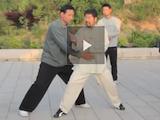We continue on the exercise with one knee up and one knee down from last week.
The torso is like a cylinder that goes down in a free-fall fashion. We can hold up the cylinder, and yet we can’t push down the cylinder. The cylinder is pulled down by gravity, something is outside of our body.

It is like the cylinder dropping through an iris shutter valve as the opening is big enough to allow the cylinder to go through. The knee going up and down opens up this hole.
Ultimately, when the knee goes down, it does not really go down. There is a restriction that is place in front of the knee.
As the cylinder goes down, there is also a rotation on the cylinder.
For now, we need to make sure that the knee that is supposed to go down does not go towards the other knee. It goes in the direction that is perpendicular to the line originally formed between the two knees.
On Nov. 11, 2020, Master Chen added the following in this topic:
Regarding the knee going down, this projects one line that is perpendicular to the line originally formed between the two knees. These two lines form a T in terms of how they interact with each other. Along with one end going down, and the other going up, this actually creates a spiral.

Master Chen also showed the demonstration using two credit cards standing on their edges, and forming a T with a little gap at the bottom of the interaction. Without such gap, the two cards won’t be able to stand up.If there is no gap, you can say the entire side is touching, but then it is the same as the entire side is not touching. The two cards won’t be able to stand up. With that gap, there is one point that the two cards are definitely touching at, and then many points that the two cards are not touching. That is separation of yin and yang. Another way of looking at is that the gap does not belong to either card, but the two cards are related because they are touching at one point.
Examples:
- Two feet form a line, and coccyx stretches perpendicular to that line.
- In Cloud Hands, we have one positive circle on one plane, and the other positive circle going on another plane that is perpendicular to the first one. Further more, we can have one circle (think of it more like a square) having power on the top and bottom sides, while the other circle having power on the left and right sides. The gap is in the space in the armpit. These actions and intentions are what make our movements 3D.



